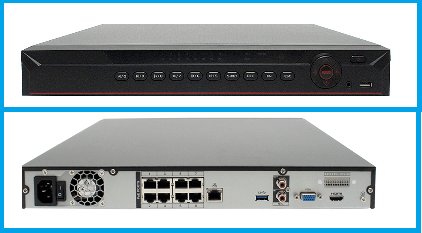Onboard POE NVRs from SCK!
One of the most sought after CCTV features is ease of installation, and ease of use- our Onboard POE NVRs make setup a breeze! But what makes onboard POE NVRs special, and what sets them apart from other NVRs? Well first, its important to understand what POE is.
If you’ve worked in CCTV for a long time, you may alreayd be familiar with POE. POE stands for Power Over Ethernet, which is an amazing solution used to provide electrically powered network devices with both power and a data conduit all over a single cat5e or cat6 cable (also known as an ethernet cable, hence the name power over ethernet).
POE is used all over the tech world, not just in CCTV. The standfard form of POE is used to power all sorts of things, a more common example would be a VoiP telephone. There are also other formats for POE, which provide additional usablity for various cistumstances. POE+ (also known as Hi-POE), and POE. All 3 of them serve varied purposes but all ultimately perform the same function- to provide power and data to the kind of devices that need it. They do this, however, in varied ways and you use them in different circumstances.
So now you know that POE provides power and data to cameras, and that gives us a foundation. Next lets talk NVRs.
Another aconym in CCTV, NVR stands for network video recorder. Unlike DVRs which can use coax cameras and sometimes also IP cameras, NVRs work esclusivley with IP cameras. Just like DVRs, NVRs come in different shapes, sizes, and channel counts.
So as the name implies, NVRs connect to IP cameras over a network, often times this is a local PC network managed by a router. In this case, a device called a POE switch is usually used in order both power the IP cameras whilst simultaneously proividing network connectivity. The switch itself would be connected back to the same router your devices, including an NVR, would be utilizng. Once on the same network and powered up, the cameras and NVR can then talk to each other.
For larger installations, this is usually the reccomended route. This provides a lot of hands on control over the cameras and their interfaces. Generallly this setup is for larger installations and/or advanced users as it requires a bit of networking knowhoe to configure. Additionally for installations of such a signfigant scope or complexity a local trusted installer is always reccomended.
But what about a much smaller system, for something like a house or apartment. Isn’t theree a mroe plug and play solution, somethign that doesnt require as much setup?
Yes there is, and thats wheere onboard POE NVRs come in!
Onboard POE NVRs are simply NVRs that have a POE switch embedded into the NVR itsself. This POE switch is managed by the NVrs hardware and software. It can provide power and network data to the cameras right from the NVR. Additionally these types of systems are designed to automaitrcally assign IPs, initlize, connect to, and record IP cameras that connect direcvtly to the onboard POE of the NVR. This process makes installation and setup a lot simpler with little to no networking exsperience required.
If youre looking for a solution that can get your home protected but dont want to deal with an expensive installation, an onboard POE NVR and IP cameras are probbaly the best way to go! Chck out this link to see some of these awesome systems!
4 AND 8 CHANNEL ONBOARD POE NVRs
For more information on POE, check out the video below!
Thanks for joining us today as we talked about POE NVRs! For any questions on product compatibility, availability or any other information don’t hesitate to give our Sales Pro’s a call at 561-288-5258 . Don’t forget to subscribe to our YouTube Channel for more Tutorials and CCTV info. Until Next time, Stay Safe!
Related: What’s the difference between DVR and NVR?
Related: What’s the difference between H264 and H265?
Related: IP PTZ Security Cameras – All There is to Know
Related: Resolution, and why does it matter?
Related: What are active deterrence cameras?
Find Us On: Facebook | Twitter | YouTube












